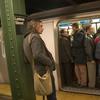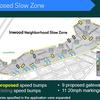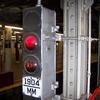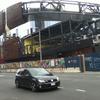Jim O'Grady appears in the following:
In a Heat Wave, Don't Expect the MTA to Cool Subway Platforms
Wednesday, June 20, 2012

Every summer, as the heat builds and the atmosphere in the subway acquires the texture of a hound dog's mouth, straphangers wonder why stations aren't air conditioned. If train cars are reliably cooled, the thinking goes, why can't something be done to cool customers while they wait for them?
Don't Expect Cooling On NYC Subway Platforms -- Especially During a Heatwave
Wednesday, June 20, 2012
Safety bumps on a platform's edge look like proverbial fried eggs on a hot day in the subway. (Photo by Susan NYC / flickr)
(New York, NY - WNYC) Every summer, as the heat builds and the atmosphere in the subway acquires the texture of a hound dog's mouth, straphangers wonder why stations aren't air conditioned. If train cars are reliably cooled, the thinking goes, why can't something be done to cool customers while they wait for them?
The NY Metropolitan Transportation Authority's answer: "Unfortunately, air conditioning of subway stations is not feasible due to the open nature of their construction and the impossibility of cooling an infinite space." Spokeswoman Marjorie Anders explained that the system is open, in part, to cool it: the movement of trains pushes hot air from the tunnels out through vents in city sidewalks.
The exception is Grand Central Terminal, which has air conditioning in The Main Concourse, an enormous central space through which 75,000 to 100,000 passengers pass daily. Anders said seven huge cooling towers on the terminal's roof work in tandem with dozens of temperature sensors to cool the hall. She said that's easier to accomplish at the start of summer because "the building isn’t heat-soaked yet. The concrete, limestone and marble are still cool to the touch."
Ms. Anders spoke by phone from an office at the NY MTA's Midtown headquarters that had been darkened, she claimed, to save energy. She said that though The Main Concourse is air-conditioned, the gigantic underground train shed at Grand Central Terminal, which holds 123 tracks and 46 platforms, is not.
Ushers keep doors between the terminal and the platforms closed when trains aren’t actively boarding or unloading. And conductors on the trains only open one door per car when a train is in Grand Central.
The NY MTA is also coping with the heat wave by reducing the speed of subway trains and reducing electrical usage by shutting down several substations that supply power to the system's third rails. That means subways are moving a little bit slower.
The authority says it cuts back on power during heat waves between noon and 6 pm at the request of the New York State Power Authority.
On subway lines, passengers may notice reduced elevator and escalator service, to conserve energy. Some contracts with energy providers require the NY MTA to reduce power consumption during heat waves.
The authority will also be running trains at reduced speed on Metro-North's New Haven Line, which is powered by overhead catenary wires that droop in extreme heat. "Trains are slowed so that pantographs – arm-like apparatus on the roof of the trains that draw the power from the catenary - do not get ensnared in catenary wires," a spokesman said.
NYC Mayor Bloomberg: Cities Are Ahead Of Nations In Reducing Greenhouse Gases
Tuesday, June 19, 2012
New York Mayor Michael Bloomberg (photo by NYC Mayor's Office)
(New York, NY - WNYC) By the end of the decade, climate-related actions taken by cities around the world will reduce greenhouse gases by 250 million tons per year. That's what New York Mayor Michael Bloomberg told delegates at the Rio Earth Summit. He added that by 2030, the annual reduction of greenhouse gases by major cities could be a billion tons per year--the combined output of Mexico and Canada.
Bloomberg was addressing the Rio+C40 Summit, which he said includes 59 cities "from Bogota to Berlin, from Jakarta to Johannesburg, and from my New York." One of every 12 people on the planet live in those cities, he said, and account for about 14 percent of the world’s total carbon footprint.
“The world is rapidly urbanizing," Bloomberg said. "Cities are becoming bigger and bigger. Our problems are sometimes harder and harder to tackle. Yet we continue to make major progress, even in times of tough budget cuts."
He said New York City has shrunk its carbon footprint by 13 percent in the past five years, and praised other cities for taking similar steps.
“Let me point out that nearly two-thirds of the climate change actions the C40 cities have taken have been paid for solely from our budgets – without support from our national governments," he said. "That’s because cities recognize our responsibilities to act; we haven’t waited for our national governments to go first."
Bloomberg also announced initiatives to improve the management of city solid waste, including reducing the release of methane and other greenhouse gases, and a web site "to provide a broad, deep, and constantly updated library on what the world’s cities are doing about climate change – and about the tools and resources cities can use to further their work."
Go here to read the mayor's full remarks.
NY MTA Chief Says Railroads Need To Work Together To Overcome Maxed-Out Hudson River Crossings
Thursday, June 14, 2012
Amtrak concourse at Penn Station in New York. (Scott Beale / flickr)
(New York, NY -- WNYC) New York Metropolitan Transportation Authority Chairman Joe Lhota told a conference of transportation professionals that the only hope for moving more people under the Hudson River between Manhattan and New Jersey is for the area’s commuter railroads to set aside their traditional enmity and work better together.
His remarks came after a presentation showing rapid growth in New Jersey’s commuter population has maxed out rush hour crossings — both transit and vehicular — and that relief in the form of a proposed Gateway Rail Tunnel won’t arrive until 2025. If it arrives.
Which raised the question: what to do in the meantime?
Lhota tossed out three ideas, each aimed at boosting capacity at Penn Station in Manhattan, the hemisphere’s busiest railroad station and a terminal for New Jersey Transit trains.
He said the station’s 21 platforms should all be made to accommodate 10-car trains, which would mean lengthening some of them. He also said that the railroads using the station—Amtrak, New Jersey Transit and Long Island Rail Road—should do a better job of sharing platform and tunnel space.
Each railroad currently controls a third of the platforms, which sometimes leads to one railroad having too many trains and not enough platforms at the same time another railroad has empty platforms. The railroads also vie with each other for access to tunnels during peak periods. Lhota said capacity would be boosted if dispatchers in the station’s control room could send any train to any platform, and through any tunnel, as they saw fit.
Lhota’s third suggestion was the most ambitious. He said the three railroads—plus the MTA’s Metro-North line, which connects Manhattan to Connecticut and several downstate New York counties—should use each other’s tracks. In other words, trains should flow throughout the region in a way that sends them beyond their historic territory. For example, a train from Long Island could arrive in Penn Station and, instead of sitting idly until its scheduled return trip, move on to New Jersey. That way, trains would spend less time tying up platforms, boosting the station’s capacity.
The practice is called “through-running.” It happens already when NJ Transit trains carry football fans on game day from New Haven, Connecticut, through Penn Station to Secaucus, where passengers transfer to a shuttle that takes them to MetLife Stadium in the Meadowlands.
Lhota says more trains crossing borders would make for a truly regional and efficient system. But first the railroads must cooperate. "Right now, we're as Balkanized as you can possibly imagine,” he said. “We need to find a way to coordinate that."
MTA spokesman Adam Lisberg said running the football train is complicated but shows that cooperation is possible. “Doing just this experiment required agreements among four railroads to coordinate schedules, crews, track, ticketing, revenue and some minor hardware issues,” he said. “So expanding it to full-fledged through-running will take much more.”
Lisberg said the four railroads are conducting a $1.5 million study to look at improving Penn Station’s capacity. “The study is trying to quantify the benefits and the costs of through-running,” he said. One of those costs would be overcoming the railroads’ disparate technologies: Amtrak, Metro-North and NJ Transit use overhead catenary power, while Long Island Rail Road is powered by a third rail.
In an email, Lisberg further weighted the costs and benefits of through-putting. He said a big advantage would be that trains wouldn’t have to stop and turn around in Penn Station, “or use precious tunnel slots to move empty trains into storage yards.”
And he said the existing tracks and platforms under the station “could be reorganized into simple eastbound and westbound tracks and platforms, regardless of which railroad uses them.” Then he added a caveat: “However, it would require lots of capital investment and changes to existing procedures – and we want to know it can be done without affecting on-time performance.”
The Regional Plan Association, which held the conference at which Lhota spoke, and other advocacy groups have expressed support for through-running—at least until Gateway Tunnel gets built. If it gets built.
'Lost Subways' Goes Live At New York Public Library
Tuesday, June 12, 2012
What might've been. (WNYC Map)
(New York, NY - WNYC) New York's Lost Subways loom large in the mind for things that aren't there.
Our January post, map and radio feature about the city's "ghost system" of never-built or abandoned lines sparked a robust public reaction. More than 5,700 TN readers talked them up on social media. And that fearsome cultural arbiter, New York Magazine's Approval Matrix, placed us not in the page's Lowbrow / Despicable quadrant -- where we always thought we'd end up -- but the Highbrow / Brilliant quadrant.
Best of all, New York Public Library took notice and invited us to cross the threshold of the esteemed Mid-Manhattan branch and give an illustrated talk about our lost subways research -- where they would've gone and why they weren't built -- and how tricky it was to come up with the post's cool interactive map.
The presentation happens this Thursday at 6:30 p.m. with Jim O'Grady, WNYC reporter and TN contributor, and John Keefe, Senior Editor for Data News & Journalism Technology at WNYC.
Come by to say hello! And comment below to let us know where you'd build a new subway.
NY MTA Upping Service On L Train To Reduce "Sardine Crush" Of Riders
Monday, June 11, 2012
It's not uncommon for riders during the morning rush to let an overcrowded L train go on without them. (Runs With Scirssors/flickr)
(New York, NY - WNYC) Several New York City subway lines are at or above capacity. Relief is coming for some riders because of technology.
The chronically overcrowded L train, which connects Manhattan to Brooklyn's fastest growing neighborhoods, is now running 98 more times a week. The NY Metropolitan Transportation Authority just finished installing a new radio-based signal system that allows trains on the line to travel closer together and, as a result, more frequently.
Brooklyn Democratic District Leader Lincoln Restler, who joined elected officials at a press conference outside the Bedford Avenue stop in Williamsburg, Brooklyn, said it's about time. "The complaint I receive most frequently about quality of life for Williamsburg residents is L train service," he said. "It is terrible. We've been unable to fit onto trains for too long."
Ridership on the L train has grown 141 percent since 1998 because of a population boom in Williamsburg and Greenpoint, the chosen enclaves of NYC's hipster set and more recently, a hub of new condo construction. It's not unusual for riders during the morning rush to let a packed train pass because there's no room to board it.
The NY MTA announced a plan to increase service on the line eight months ago, which led to a squabble with its largest union over why the new schedule would take so long to implement.
Riders will now see 16 more trains on weekdays and 18 more trains over the course of a weekend.
The MTA says, during the morning rush, customers can shave 30 seconds off their wait with trains now arriving every 3 minutes. Non-rush hour weekday riders, as well as Saturday night revelers, can expect a train every six minutes, down from 7 ½ minutes. And Sunday evening straphangers can expect a train every 6 minutes, down from 8 ½ minutes.
State Senator Daniel Squadron said those improvements should lessen claustrophobia on the line. "That means that you're going to spread out that sardine can crush. It'll still be standing room only but it'll at least get us below over-capacity."
The NY MTA said the added service will cost $1.7 million annually.
MTA Upping Service on L Train to Reduce ‘Sardine Crush’ of Riders
Monday, June 11, 2012

The chronically overcrowded L train is now running 98 more times a week. The MTA just finished installing a new radio-based signal system that allows trains on the line to travel close together and, as a result, more frequently.
London’s Mayor: Bike Share Will Civilize New York
Monday, June 11, 2012

The New World can still learn a thing or two from the Old World – especially when it comes to transportation. Just as London had the tube before New York City got the subway, London has had a bike share in operation before New York City.
London's Mayor: Bike Share Will Civilize New York
Monday, June 11, 2012
London Mayor Boris Johnson. (photo by hammersmithandfulham / Flickr)
(New York, NY - WNYC) When we heard that Boris Johnson, Mayor of London, would be sitting for an interview with show host Leonard Lopate in a studio at WNYC, we made sure to plant a transportation question.
Lopate: Our news department wanted us to ask if you have any advice for New York as it launches its bikeshare program next month.
Johnson: My advice is, 'Enjoy it.' I think it's high time that New York had it. It's a great scheme; it will go well.
Johnson then described how London's bikeshare program has transformed street life in Great Britain's capital city, and what New Yorkers should brace for.
Johnson: I think drivers have got to learn to recognize they are going to find bikes on the streets. It's just a fact of life, and it will civilize the place. It will improve the atmosphere. There's nothing more immediately redolent of a village than loads of people wobbling around on bicycles.
Understandably, Lopate was suspicious of the idea that New Yorkers could be civilized, especially compared to Londoners.
Lopate: London's always had a bicycle culture. And bicyclists, at least when I rode around London, actually observed the traffic rules. We would signal left turn, right turn, and not go through red lights. That doesn't happen in this city. Has there been the kind of war between drivers and bicyclists that we've seen in New York?
Johnson: I wish everybody was as punctilious as you are, Leonard. I'm going to have to confess to you that we've got some bad habits now in London. There's loads of people who jump red lights, ride on the pavement, intimidate pedestrians and disobey the rules of the road. If any of them are listening, they know who they are.
Despite such problems, bikeshares have come a long way since the 1960s, when a Dutch anarchist group collected several hundred bicycles, painted them white and left them lying around Amsterdam to be used for free--a bold stroke that inspired this super-groovy song. Today's bikeshares, like Barclay Cycle Hire in London, tend to be organized, branded and growing.
Johnson: We've seen a massive expansion of cycling in London. Last year alone, it's gone up 15 percent. The cycle scheme we've got in is expanding very fast. We're at something like 40,000 rides a day. We will go further.
Still, the Mayor of London ended with a cautionary note about the need for police to crack down on bad actors.
Johnson: But there's got to be a reciprocal understanding by cyclists that they've got to obey the rules of the road.
Are you listening, New York City?
Here is a video about how London's bikeshare works:
Manhattan On Track To Get Its First Slow Zone
Monday, June 11, 2012
Proposed Slow Zone for the Inwood section of Manhattan (NYC DOT)
(New York, NY - WNYC) - Manhattan, where the standard rate of movement is an all-out manic sprint, is about to be told by the NY Department of Transportation to slow down. At least in part: a couple of dozen blocks at the island's northern tip in the neighborhood of Inwood are on track to become the borough's first traffic Slow Zone.
NYC DOT unveiled Slow Zones last year. The program calms traffic by lowering a neighborhood's speed limit to 20 miles per hour--the lowest in the city--and fitting it out with safety measures such as speed bumps, signs and street markings that either force or urge drivers to slow down. The city would also remove more than 20 parking spots in the neighborhood to open up sight lines at intersections.
Inwood's community board passed a resolution in February that unanimously supported the Slow Zone, which would cover the blocks west of Broadway from West 218th down to Riverside Drive near Dyckman Street. A vote by the full board will be held on June 26. Should the Slow Zone be approved, as expected, the NYC DOT is set to install it this summer.
Inwood is frequently used as a short-cut by northbound drivers who cut through it, especially during the evening rush hour, to avoid paying the toll on the Henry Hudson Bridge, which spans Manhattan and the Bronx. Drivers have also learned to avoid the traffic lights on Broadway by traveling on Seaman Avenue, a parallel street that is heavily residential.
In general, Inwood's streets are hilly, narrow and almost wholly disconnected from the street grid. For those reasons, the NYC DOT not only approved the neighborhood's Slow Zone application but doubled the size of the proposed area.
Resident Dave Thom, for one, is pleased. "Our neighborhood is packed with schools, churches and young children," he said. "I have a two year-old and three year-old myself and it can be nerve-wracking to see a car racing down our streets."
The city's first and only Slow Zone was installed in the Claremont section of the Bronx last year. NYC DOT is considering adding another 13 Slow Zones, including the one in Inwood, by the end of 2013.
Manhattan On Track To Get Its First Slow Zone
Monday, June 11, 2012

Manhattan, where the standard form of motion is an all-out sprint, is about to be told by the NY Department of Transportation to slow down. At least in part: a couple of dozen blocks at the island's northern tip in the neighborhood of Inwood are on track to become the borough's first traffic Slow Zone.
Report: Transit Fares High and Rising? Blame Bailed-Out Banks
Thursday, June 07, 2012
 (New York, NY - WNYC) A transit union says in a report that one cause of the New York Metropolitan Transportation Authority's recent fare hikes and service cuts has been hiding in plain sight: financial arrangements called interest rate swaps. Those are deals the authority made with banks on 10 percent of its $33 billion of debt —deals that have gone against the authority and in favor of the banks.
(New York, NY - WNYC) A transit union says in a report that one cause of the New York Metropolitan Transportation Authority's recent fare hikes and service cuts has been hiding in plain sight: financial arrangements called interest rate swaps. Those are deals the authority made with banks on 10 percent of its $33 billion of debt —deals that have gone against the authority and in favor of the banks.
The deals were made between 1995 and 2007, when banks agreed to cover the fluctuating interest rates on some of the authority's bonds. In exchange, the NY MTA said it would pay the banks a fixed rate, plus a small premium. That agreement would've protected the authority if rates had jumped up. But the Amalgamated Transit Union says the NY MTA has taken a net loss on the deals since the economy crashed in 2008 and interest rates fell to sustained, historic lows.
The union says the authority is now losing almost $114 million a year ― and could continue to lose money on the deals for the next 20 to 30 years.
NY MTA spokesman Adam Lisberg disputed the union's calculations, saying the swaps brought predictability to the authority's budget, which needs to be balanced each year. "To compare transactions we entered into years ago, compared to what you can get in risky variable rate debt right now is either irresponsible or deliberately misleading," he said. "They are simply wrong."
He contended that the swaps allowed the authority to save $248 million. The report says that was true until 2007, when the arrangement allowed the NY MTA to pay off its debt at nearly a full point below interest rates that were relatively high. But that was before the economy tanked. Since then, the authority has lost money on the deal.
The report looked at 12 transit agencies or local governments that entered into interest rate swaps. The report's authors insisted in a conference call that, though the deals may have made sense when they were struck, these 12 agencies ― which includes the NY MTA and NJ Transit ― are now bleeding at least a half a billion dollars a year from the budgets of governments and transit authorities around the United States.
James Parrott, an economist with the Fiscal Policy Institute, called on agencies like the NY MTA to seek concessions from the banks, many of which received massive taxpayer bailouts.
He said he doesn't understand why the NY MTA isn't treating its bankers like any other business partners. “The MTA went to all of its vendors from 2008 to 2010 and got concessions from them to reduce the price of contracts," he said. "The only business they didn’t go to is the banks. Why?”
Parrott also noted that the NY MTA is about to go to market to sell billions in new bonds to refinance its capital construction program. "They could say to the banks, ‘If you’re unwilling to renegotiate these credit swaps, we’re not so sure you’re going to get a piece of these bonds,'” he said.
Lisberg called the idea unrealistic. "We need these major banks to provide financing for us," he said. "We’re constantly in the debt markets, it’s how we and every other large government organization works. If we’re buying equipment to use over 30 years, it makes sense to pay for it over 30 years."
In 2010, the NY MTA plugged a budget gap by laying off 1,000 workers and eliminating 750 positions. It also enacted some of the deepest subway and bus service cuts in decades. Riders absorbed a 7.5 percent fare increase in 2011, and further 7.5 percent increases are scheduled in 2013 and 2015.
The banks that hold interest rates swaps with the NY MTA are JPMorgan Chase, Citigroup, UBS, AIG, Morgan Stanley, BNP Paribas and Ambac.
Report: Transit Fares High and Rising? Blame Bailed-Out Banks
Thursday, June 07, 2012

A transit union says in a report that one cause of the MTA's recent fare hikes and service cuts has been hiding in plain sight: financial arrangements called interest rate swaps. Those are deals the authority made with banks on 10 percent of its $33 billion of debt —deals that have gone against the authority and in favor of the banks.
A Latina Journalist, a Former Clinton Official, and a Big Political Donor Join Port Authority Board
Wednesday, June 06, 2012
The George Washington Bridge is one of six bridges and tunnels operated by the NY-NJ Port Authority. (Photo by Phil Davis NY / Flickr)
(New York, NY - WNYC) NY Governor Cuomo lets no appointment go unmined for good political effect. This round of appointments to the Port Authority Board is no exception: Cuomo has named a prominent Latina journalist, a real estate developer (and big political fundraiser), and a former top Clinton administration official to the Port Authority board.
The three appointees are El Diario/La Prensa Publisher Rossana Rosado, former state department spokesman and Bloomberg View editor James Rubin and real estate mogul -- and big-time political donor -- Scott Rechler.
Rechler has been serving on the board for the past year as vice chairman; his term will expire July 2018. Rosado and Rubin will take their seats immediately. Rosado's term ends July 2014, Rubin's term ends July 2017.
Rechler is the CEO and Chairman of RXR Realty, which owns and operates office buildings in the New York area, including some fancy addresses in Manhattan, and is worth about $4.5 billion. NYPIRG named him one of the biggest political donors in the state. He gave $55,000 to Cuomo's campaign, the group said. In 2008, he raised some $140,000 for the Obama campaign, according to the non-partisan Center for Responsive Politics.
The NY-NJ Port Authority's facilities include America's busiest airport system, marine terminals and ports, the PATH rail transit system, six tunnels and bridges between New York and New Jersey, the Port Authority Bus Terminal in Manhattan, and the World Trade Center. Last year, the authority moved 104 million airport customers, 74 million PATH train riders and saw 121 million vehicles cross its bridges and tunnels. The port handled 5.2 million cargo container units.
The commissioners vote on how to allocate billions in public funds to major transportation projects.
In the past Cuomo has appointed former Bronx Borough President (and current lobbyist) Fernando Ferrer to the MTA Board, and big developer/donor Howard Milstein to head the New York State Thruway.
BREAKING: Federal Investigators: Almost Everything Went Wrong in Bronx Bus Crash That Killed 15
Tuesday, June 05, 2012
NTSB Photo
Almost everything seems to have gone wrong in last year's fatal Bronx bus ride from a Connecticut casino that left 15 dead. That's according to the National Transportation Safety Board's final report on the March 11, 2011 crash. The gruesome accident brought on a cascade of criticism about safety in the rapidly growing inter-city bus industry, proposals for federal and state legislation, and tough Department of Transportation crackdowns.
The driver had seven license violations and was suspended eight times in the six years prior to the crash -- but lied to his employers about that. In the three days before he drove off I-95, he got almost no sleep.
Truckers saw him traversing rumble strips, and watched as the driver made no correction and drifted off the road before hitting a guard rail. And the guard rail was "not designed to re-direct a heavy vehicle such as a motor coach," investigators said.
Investigators also ran simulations that showed seat belts, which were not available to the passengers, could've saved lives and prevented injuries.
The NTSB also released an animation showing the bus careening along the guard rail before crashing into a sign and tipping over the edge.
NTSB investigator Tom Barth said the passengers returning from the casino trip "had planned to gamble, but not with their lives."
We'll link to the report as soon as it's posted.
Raptor Chicks Add Grace Note, Guano to City Bridge Heights
Monday, June 04, 2012

VIDEO: Atop NYC Bridges, Baby Falcons Thrive in Homes with Great Views
Monday, June 04, 2012
(New York, NY - WNYC) Peregrines prefer peaks. In New York City, that means the flat tops of tall bridges. Once again, it's time to cinch up the safety harness, scale a few feats of infrastructure and count hatchlings.
The NY Metropolitan Transportation Authority, always casting about for ways to improve its perennially embattled image, has in recent years embraced and promoted its role as Haven of Hatcheries. The authority has allowed the city Department of Protection to build shelters for raptors atop its bridges, and to let city conservationists go into them once a year and band the newborn birds they find. The shelters are no-frills affairs with guano-speckled roofs. And the banding, according to Chris Nadareski, the conservationist in the video, doesn't hurt the birds--though it must be said, those chicks don't seem pleased.
This year's total of newborn falcons on three bridges operated by the MTA: seven. Their wide-eyed adorableness on a scale of 1 to 10: 10. Interesting stat: when diving for prey, peregrines can exceed 200 miles per hour, making them the fastest birds in the world. It also puts them in sync with the city's unofficial motto: "Move swiftly or starve. "
New York City is home to more than 20 pairs of peregrine falcons. Two of the newest ones are called Lief and Skye, which are names you can soon expect to be attached to Brooklyn tots. The birds were nearly wiped out in the 1960s because of pesticides and remain on the New York State endangered list. But, thanks in part to the MTA's hospitality, it is increasingly common to see a raptor in search of a fish wheeling in the sky above the harbor. Hence the video's closing invitation+ warning:
"Look for the peregrine falcons...but not while you're driving."
Video:
Council Members Want Grades for Subway Stations
Wednesday, May 23, 2012

Some City Council members are pushing for subway station grading system similar to the one used to rate restaurants’ cleanliness – but the MTA is red-lighting the proposal.
Parking Slashed By Half In Plan For Barclays Center In Downtown Brooklyn
Wednesday, May 23, 2012
Consultant Sam Schwartz presents his traffic management plan for the Barclays Center at a public hearing in downtown Brooklyn. (Jim O'Grady/WNYC)
(New York, NY - WNYC) Don't even think of driving to the Barclays Center when it opens on September 28. That was the thrust of a traffic management plan presented by consultant Sam Schwartz at a public hearing in downtown Brooklyn on Tuesday.
"We're going to reduce the number of cars coming to the arena," Schwartz emphasized. "That's our mantra."
The plan would cut parking at the Barclays Center, future home of the Brooklyn Nets, from 1,000 to 541 spots. Ticket-holders will be urged to arrive by Long Island Rail Road or one of eleven subway lines that meet beneath the arena. Schwartz says another way of keeping vehicles out of the heavily congested area will be to encourage drivers to park at a half-priced lot a mile away near the Brooklyn-Queens Expressway, and take a free shuttle bus.
However, the arena's website makes clear that suite-holders will get priority parking: " You will have a reserved spot within a one to two block radius from the premium entrance. Important to note that our parent company controls parking both on the Arena site and surrounding areas that will enable us to deliver the most convenient parking access possible to our suite customers." Jane Marshall, a spokeswoman for arena developer Forest City Ratner, said 150 of the 541 spots will be reserved for suite and season-ticket holders.
The Schwartz plan also calls for HOV spaces for cars with three or more people. And if drivers want to park near the arena, they'll be encouraged to go online and pay for a reserved spot at a lot or garage before leaving. Schwartz said that should cut down on drivers circling the area while deciding where to park. And the plan offers yet another incentive to leaving the motorized vehicle at home: 400 bicycle parking spots.
Despite such measures, car owners who live near the Barclays Center still worry that people driving in to attend a Nets game or concert will take up all the parking spots in nearby neighborhoods, especially now that the Schwartz plan seeks to slash the number of spots at the arena.
Those residents learned that the city won't be granting their request for residential parking permits any time soon. The New York City Department of Transportation's Christopher Hrones said his agency is still studying the issue.
"We're not in a position, for several reasons, to have a residential parking permit in place when the arena opens on September 28th," he said. He added that even if the city were to approve a parking permit program, it would need permission from the state, and that takes time. Because of the format of the evening -- questions submitted on cards with no possibility of follow-up -- there wasn't an opportunity to get further clarification on residential parking permits.
Around Yankees Stadium in the Bronx, motorists continue to look for on-street parking to the consternation of local residents, as we've reported.
The arena's traffic management plan now enters a 30-day public review period.
In Plan For Barclays Center, Parking Slashed By Half
Tuesday, May 22, 2012

You’ll want to think twice, or maybe even a third time, before deciding to drive to Barclays Arena when it opens on September 28. The parking plan for Barclays is being cut from 1,000 to 541 spots.



















